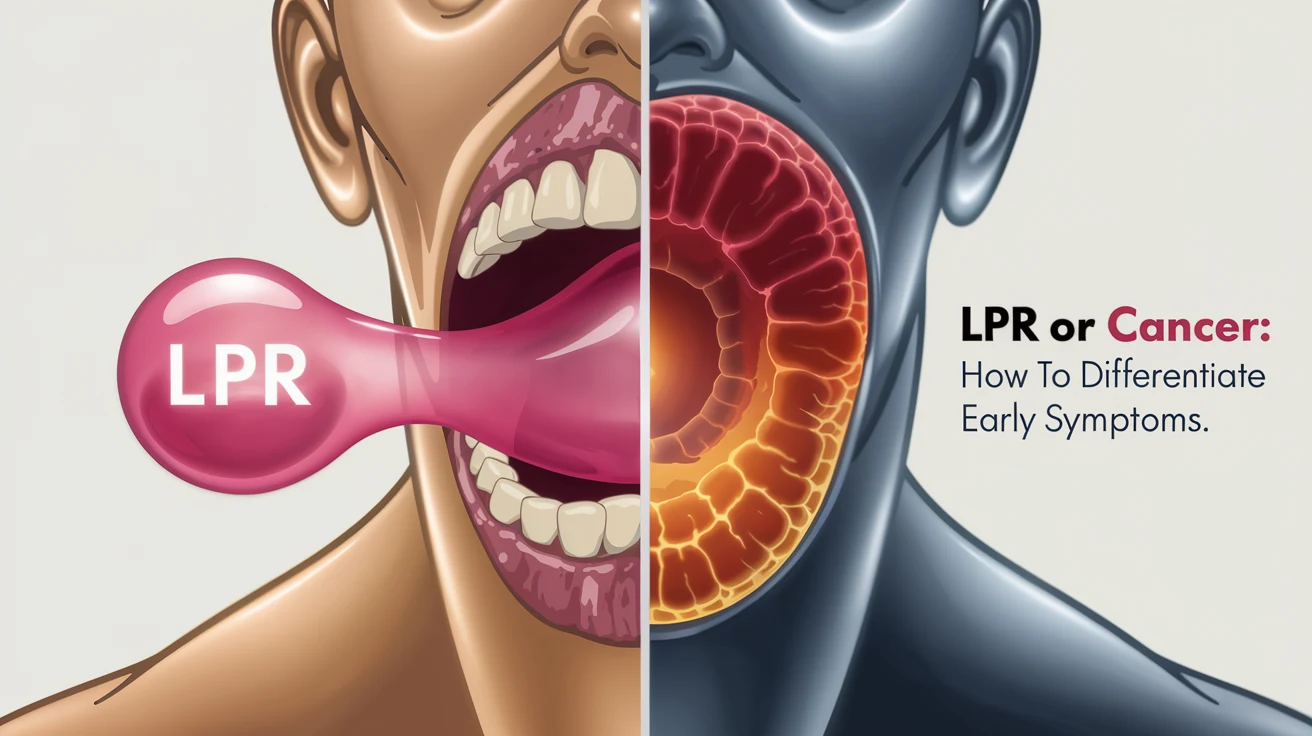

Laryngopharyngeal reflux (LPR), commonly known as silent reflux, and certain types of cancer, such as throat or esophageal cancer, can share overlapping symptoms, which makes distinguishing between them particularly difficult. Early detection and proper diagnosis are critical for effective treatment. This guide will help you understand the key differences and provide insights into when to seek medical advice.
Silent reflux, or laryngopharyngeal reflux (LPR), occurs when stomach acid travels upward into the throat and voice box, often without the classic symptoms of heartburn. Stomach acid can reach the throat, leading to symptoms in that area. It is referred to as 'silent reflux' because it often lacks the typical symptoms of acid reflux, like heartburn, making it harder to detect. Unlike GERD, which typically causes heartburn, LPR presents more subtle symptoms such as hoarseness, laryngitis, and chronic throat clearing.
LPR, also known as 'extraesophageal reflux,' differs from GERD in that it affects the upper oesophagal sphincter (UES) rather than just the lower oesophagal sphincter (LES). More than half of individuals with chronic hoarseness may have LPR, making it a common but underdiagnosed condition.
Throat cancer involves the development of malignant tumors in the pharynx, larynx, or esophagus, and it demands immediate medical attention due to its serious nature.
Smoking and tobacco use
Excessive alcohol consumption
Human papillomavirus (HPV) infection
Poor diet or nutritional deficiencies
Chronic acid reflux or GERD
Family history of cancer
| Symptoms | LPR | Cancer |
| Persistent throat clearing | Common and persistent | Rare |
| Hoarseness | Intermittent and mild | Progressive and persistent |
| Lump in the throat feeling | Common (not associated with a real mass) | Could indicate tumor presence |
| Difficulty swallowing | Mild | Severe and progressively worse |
| Blood in phlegm/saliva | Rare | Possible sign of advanced cancer |
| Weight loss | Unlikely | Common |
If you experience overlapping symptoms, consulting a specialist is essential. Diagnostic tests can help determine whether your condition is due to LPR or cancer. Understanding the importance of a differential diagnosis is crucial, as it allows the doctor to rule out other conditions and focus on the most likely causes of your symptoms.
LPR Diagnosis:
pH Monitoring: Measures acid levels in the throat using sensors placed for 24 hours.
Endoscopy: Visualizes the throat and oesophagus for irritation or structural issues.
Laryngoscopy: Examines the voice box and throat for signs of inflammation or tissue damage.
Cancer Diagnosis:
Biopsy: Identifies cancerous cells if suspicious tissue is found.
Imaging Tests: These include CT, MRI, or PET scans to detect tumors or metastasis.
Endoscopic Ultrasound: Offers clear and detailed images of the esophagus and surrounding structures.
Esophageal Manometry: Assesses the strength and coordination of esophageal muscles, aiding in the diagnosis of conditions affecting the lower esophageal sphincter (LES) or upper esophageal sphincter (UES).
Early detection significantly improves outcomes, especially in cancer cases. For instance, studies show that the 5-year survival rate for localized throat cancer can be as high as 83%, compared to only 39% for advanced stages. Similarly, untreated LPR can lead to chronic irritation, increasing the risk of complications such as laryngeal cancer or respiratory issues. These statistics highlight the importance of addressing symptoms early to improve treatment outcomes.
Lifestyle Adjustments for LPR:
- Eat smaller meals and avoid lying down for three hours after eating.
- Avoid foods that relax the LES, such as coffee, chocolate, and spicy dishes.
- Sleep on your left side to reduce reflux.
- Quit smoking and limit alcohol consumption.
Preventive Steps Against Cancer:
- Avoid tobacco and alcohol use.
- Focus on having a healthy diet that is abundant in fruits and vegetables.
- Seek regular check-ups, especially if you have risk factors like GERD or a family history of cancer.
Managing laryngopharyngeal reflux (LPR) and maintaining a good quality of life requires consistent care and adjustments. Here are some practical tips to help you live with LPR:
Dietary Changes: Eat smaller, frequent meals and avoid foods that trigger reflux, such as spicy, acidic, or fried foods. Consider incorporating foods that soothe your throat, like oatmeal, bananas, or non-citrus fruits.
Hydration: Stay hydrated by drinking plenty of water throughout the day. Herbal teas with soothing ingredients like honey or marshmallow can also help.
Sleep Adjustments: Elevate the head of your bed by 6-8 inches to prevent nighttime reflux and sleep on your left side to reduce pressure on the LES.
Voice Care: Avoid overusing your voice. Speak gently, avoid whispering or shouting, and take breaks during long conversations.
Lifestyle Habits: Wear loose-fitting clothing to prevent abdominal pressure that can exacerbate reflux. Incorporate stress-reducing activities such as yoga, meditation, or deep-breathing exercises to help alleviate reflux symptoms.
Regular Monitoring: Keep a symptom diary to track any changes and share it with your healthcare provider during check-ups.
Differentiating between LPR and cancer can be challenging but is crucial for receiving appropriate treatment. Addressing factors that weaken the esophageal sphincters, like smoking, alcohol, or dietary habits, can reduce LPR symptoms significantly. If symptoms continue or worsen despite these efforts, it is crucial to consult a specialist to rule out serious conditions such as cancer.
For more information on related conditions, explore our blog on GERD vs. Esophageal Cancer: Differences and Treatments
If you are concerned about your symptoms, schedule a consultation with Dr. Parveen Yadav today for expert advice and diagnostic services. Early intervention and personalized care can make all the difference.
Follow a safe Indian diet plan after esophageal cancer surgery to support healing, improve swallowing and maintain nutrition with easy-to-digest foods.
Follow a simple week-by-week recovery guide after minimally invasive lung surgery to understand healing stages, progress and what to expect at each step.
Learn about esophageal cancer treatments including surgery, chemotherapy, radiation and immunotherapy in one simple patient-friendly guide.
Copyright 2023 © Dr .Parveen Yadav all rights reserved.
Proudly Scaled by Public Media Solution!